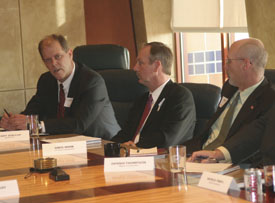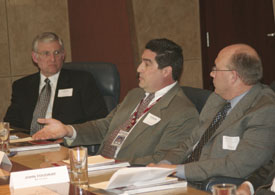 Dan Morgan points out reasons, such as Hurricane Katrina, for a 40 to 50 percent leap in some materials. Scott Stalcup and Greg Nook agree with his comments.
Dan Morgan points out reasons, such as Hurricane Katrina, for a 40 to 50 percent leap in some materials. Scott Stalcup and Greg Nook agree with his comments.Mike McClure with the City of Kansas City cited a lack of competitive bids from a range of contractors as still another reason for escalating prices. “Our bread and butter contractors,” he added, “are finding work in places like New Orleans and leaving the city.”
“We’re talking about material shortages, trade shortages. We’re living in a global economy today,” said Casey Cassias, a principal of BNIM. “It seems to me, the bigger issue is what are we building and how do we build it so that it is truly more sustainable.”
Labor Shortages
The more building there is the more stress there is on a finite labor pool. Garry Kemp with the Greater Kansas City Building and Construction Trades Council considers the greatest challenge “just having enough skilled workers nationally and locally to continue to expand the economic development base.” He sees the need for 185,000 to 200,000 new entrants each year.
John Foudray noted that the average age of a union carpenter was in the upper forties. “In 10 years,” he asked, “how many carpenters are going to be left? How many can the industry bring in and train as skilled workers?”
“The same goes for architects and engineers with the aging in America,” added Mike McClure.
“Right now we’re very lucky in the Kansas City area to have plenty of work,” observed Patrick Pribyl. “It’s just a matter of finding the right folks to get it all done.” Pribyl sees the shortage as particularly problematic for skilled subcontractor labor.
“We’ve got good qualified subs,” elaborated Dennis Thompson with Walton Construction. The challenge he sees is “to balance the price pressures” so that well-qualified subs can remain competitive and stay in the project.
 Joe Privitera talks about specific challenges faced by employers of union workers. Jack Nix and Mike McClure watch with interest.
Joe Privitera talks about specific challenges faced by employers of union workers. Jack Nix and Mike McClure watch with interest.Joe Privitera of Mark One Electric, a major Kansas City electical contractor, defined his main challenge as the disparity between the cost of the union electrician and the non-union electrician and the relative skill-sets that each brings to the job.
As an employer of union workers, Mark One “can’t compete in several of the markets because we don’t have people priced at the proper wage level to compete at that.” Outside of the city, Privitera noted, some 90 percent of the electrical work is being done by non-union electrical contractors. “If there’s one level of difficulty, they will bring in the union contractor to do that piece, but they will only get to do that piece.”
Ramin Cherafat of McCownGordon Construction added a new variable, namely capacity on the management side. He spoke of the need to train and mentor younger project managers and project engineers, especially given that “projects are getting a lot more aggressive, budgets are getting tighter.”
Local Response
When asked why the shortages were occurring, Mike McClure suggested that “there are more lucrative, more attractive industries for a youth.”
“The reality,” said Garry Kemp, “is this industry has an image problem.” Joe Privitera agreed. “On the labor end,” he noted, “whether it’s an electrician, a plumber, a fitter, a laborer is not considered a professional to a lot of people and they’re not sold as a professional.”